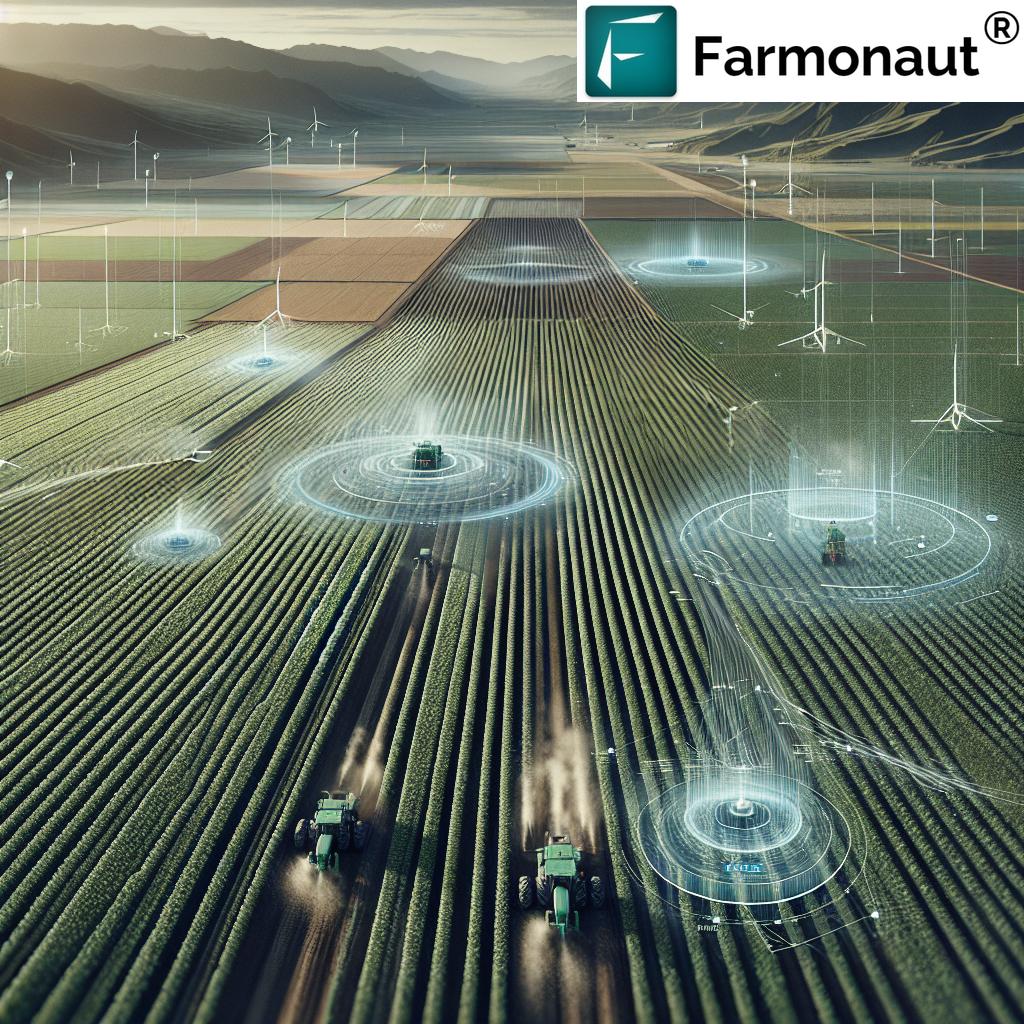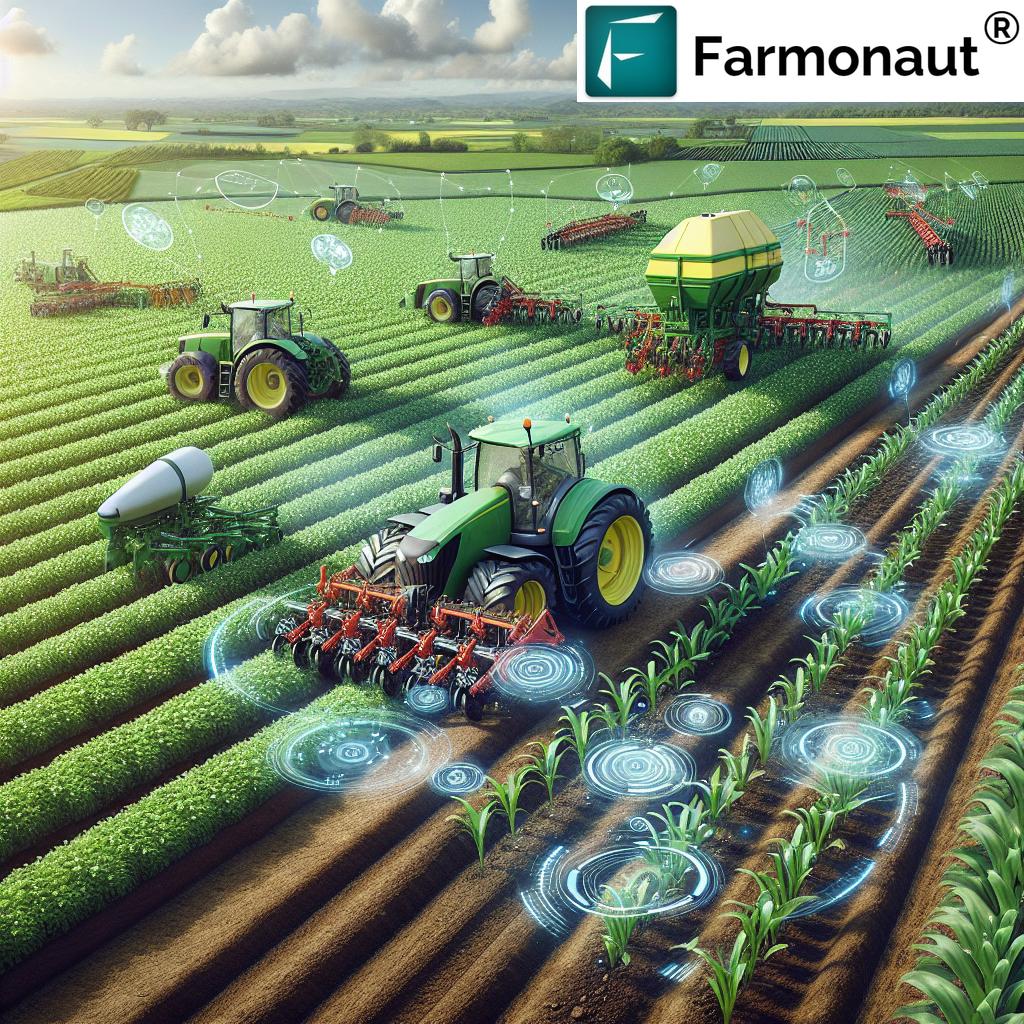Table of Contents
- What is GDU in Farming? Introduction & Quick Summary
- Trivia: Surprising Facts About GDUs
- Understanding Growing Degree Units (GDUs): The Foundation of Agricultural Heat Accumulation
- How to Calculate GDU: Base, Formula & Practical Examples
- Applications of GDUs in Agriculture: Smart Strategies for Maximum Yields
- Comparison Table: GDU Requirements for Common Crops
- Farmonaut: Revolutionizing GDU Monitoring and Precision Agriculture
- Climate, GDUs, and Crop Yield: Adapting Agricultural Practices for Changing Seasons
- Pest Management With GDUs: Winning the Battle Through Precision Timing
- Limitations and Practical Considerations of GDUs
- Farmonaut Subscription Plans for Farm and Resource Management
- Frequently Asked Questions: GDU in Farming
- GDU in Farming: Conclusion & Next Steps
What is GDU in Farming? Unlock Shocking Crop Secrets!
“Crops require 1000–1500 GDUs to reach maturity, with each crop type having a unique GDU threshold.”
As modern agriculture races into a data-driven future, understanding climate, growth cycles, and resource management has become critical for optimizing crop yield and sustainability. At the core of these strategies lies a powerful but often underappreciated metric: Growing Degree Units (GDUs). Also known as growing degree days (GDDs), GDUs serve as an agricultural heat accumulation measure that quantifies the relationship between temperature and the development stages of plants and insects. By tracking GDUs, we can plan planting schedules, predict emergence and maturity, manage pest life cycles, and make high-impact decisions that drive agricultural success. In this comprehensive guide, let’s uncover the secrets of GDUs in farming—how to calculate them, their crucial applications, and how innovators like Farmonaut are revolutionizing their use through cutting-edge technology.
Understanding Growing Degree Units (GDUs): The Foundation of Agricultural Heat Accumulation
Let us dive into the fundamental concept that underpins how modern farmers, agronomists, and horticulturists optimize field activities:
Growing Degree Units (GDUs) represent the amount of heat accumulated by a plant or insect—essentially, it’s the sum of effective warmth above a base (threshold) temperature, below which they don’t grow or develop. This metric is built upon decades of crop science and meteorology and is widely used in agriculture, horticulture, and forestry to model biological processes.
- GDUs serve as a precise measure of the relationship between daily temperatures and organism growth.
- Every crop or insect species has a base or threshold temperature unique to its physiology.
- Only the portions of the day when temperature is above this minimum threshold are “counted” toward growth or development.
For example: Cool-season crops like alfalfa might have a base temperature of 41°F (5°C); warm-season crops like corn and soybeans often use a base of 50°F (10°C). If daily averages do not exceed this base, no gdu accumulation occurs.
How to Calculate GDU: Base, Formula & Practical Examples
Calculating GDUs is remarkably straightforward—and yet so powerful in practice! The calculation for each day relies on three values:
- Tmax: The maximum temperature of the day
- Tmin: The minimum temperature of the day
- Tbase: The base (threshold) temperature for the specific crop (e.g., 50°F or 10°C for corn, soybeans; 41°F or 5°C for alfalfa)
The commonly used formula for calculating GDUs is:
GDU = [(Tmax + Tmin)/2] – Tbase
If the result is negative (i.e., daily average temperature falls below the base threshold), we set it to zero. That’s because biological activity—whether crop or insect—essentially pauses below each species’ minimum thermal limit.
GDU Calculation Example:
- Corn (Tbase = 10°C):
If the maximum temperature today was 28°C and the minimum was 12°C,
GDU = [(28 + 12) / 2] – 10 = (40/2) – 10 = 20 – 10 = 10 GDUs. -
If it’s a cool or cold day with daily averaged temperature below the base (e.g., for soybeans):
Tmax = 9°C, Tmin = 5°C, Tbase = 10°C,
Average = 7°C.
GDU = 7 – 10 = -3 (set to 0)
Farmers and horticulturists accumulate GDUs day by day after planting to estimate crop stages such as emergence, flowering, and physiological maturity. This helps us optimize all field operations, from input scheduling to pest management.
Pro Tip: For programmatic, automated GDU and weather tracking, use the
Farmonaut Satellite & Weather API and
Developer Docs for integration.
Applications of GDUs in Agriculture: Smart Strategies for Maximum Yields
Growing degree units aren’t just theoretical—they are the secret behind many cutting-edge agricultural practices. Here’s how we can effectively use GDUs in our day-to-day and strategic decision-making:
-
Predicting Crop Development Stages:
By accumulating GDUs after planting, we can predict when crops will reach essential growth milestones. For instance, gdu requirements for corn to reach full physiological maturity are around 2,700 GDUs. This aids in:- Timing applications of nutrients, water, or plant protection products
- Planning efficient harvest windows to maximize yield and quality
- Matching hybrid or variety selection to the local heat accumulation pattern
-
Optimizing Planting and Harvesting Schedules:
Understanding GDU requirements for different crops lets us plan planting schedules with greater precision. This ensures crops are exposed to optimal temperature ranges, speeding or buffering development as needed.- Adjust planting date based on spring temperatures
- Align harvesting with maturity estimates, minimizing post-maturity losses
Want more efficiency for plantations and forestry? Farmonaut’s crop plantation & forest advisory solutions can help manage these tasks at scale!
-
Managing Pest and Disease Pressure:
Many insect pests and plant pathogens develop in cycles linked to temperature. By tracking GDUs, we can predict pest emergence and outbreak risk. This leads to:- Timely deployment of targeted control measures
- Reduced reliance on broad-spectrum pesticides, minimizing environmental impact
Boost your pest management with GDUs by monitoring pest risk windows and optimizing interventions!
-
Assessing Climate Impact:
Monitoring GDUs provides a window into how climate variations and extreme heat or cold affect crop development. Farmers can leverage this data for:- Adapting crop choices or hybrids to changing seasons or microclimates
- Forecasting yield variations due to shifts in heat accumulation
- Enhancing long-term resilience of farm operations
-
Integrating with Satellite & AI Technology:
The latest ag-technology platforms—such as Farmonaut—combine satellite-driven crop health monitoring and weather models with GDU analytics, removing guesswork by offering real, actionable recommendations for every stage.
“A 1°C rise in average temperature can accelerate crop GDU accumulation by up to 10%, impacting harvest timing.”
GDU Requirements for Common Crops: Comparison Table
To help all of us plan, manage, and predict crop performance, it’s essential to know key GDU requirements for major field crops. See the table below for a quick reference guide—a vital tool for any farm manager, consultant, or ag-tech innovator aiming to leverage the power of growing degree days agriculture.
| Crop Name | Estimated GDU Range (°C) | Typical Planting Period | Key Development Milestone | Potential Yield Impact of GDU Variance |
|---|---|---|---|---|
| Corn | 1,100 – 2,700 (full season) | April – May | Emergence: ~100 GDUs Silking: ~1,000 GDUs Physiological Maturity: ~2,700 GDUs |
High (heat stress or deficit sharply reduces yield) |
| Soybean | 700 – 1,800 | Late April – June | Emergence: ~100 GDUs Flowering: ~600 GDUs Maturity: ~1,700 GDUs |
Medium-High |
| Wheat | 500 – 1,300 | October – November (Winter) | Tillering: ~350 GDUs Heading: ~700 GDUs Maturity: ~1,200 GDUs |
Medium |
| Cotton | 1,200 – 2,300 | April – May | Emergence: ~125 GDUs First Bloom: ~800 GDUs Maturity: ~2,200 GDUs |
High (especially in marginal climates) |
| Alfalfa | 250 – 1,400 (per cutting cycle) | March – September | Regrowth Cut: ~250–400 GDUs | Low–Medium (perennial, but cutting interval strongly affected) |
Note: These GDU ranges are approximate. Actual GDU needs depend on variety, climate, and management style.
By aligning crop selection and field operations with local gdu accumulation estimates, we can reliably maximize yield and reduce risk.
Farmonaut: Revolutionizing GDU Monitoring and Precision Agriculture
With digital technology propelling agriculture into a new era, Farmonaut stands at the forefront by making precision agriculture accessible, affordable, and scalable for all.
-
AI-based Satellite Crop Health Monitoring:
Through multi-spectral photography and remote sensing, Farmonaut allows users to monitor crop health, vegetation indices (e.g., NDVI), soil moisture, and GDU accumulation—all in real time. This empowers us to efficiently monitor crop growth temperature and respond to deviations instantly. -
Jeevn AI Advisory System:
Farmonaut’s personalized farm advisory engine uses GDUs, weather models, and crop stage data to deliver actionable insights, including recommended input management, harvesting advice, and pest control timing. -
Blockchain Traceability:
With traceability tools built on blockchain, agricultural products can be tracked securely from farm to store shelf. This enhances trust and transparency for both producers and consumers in sectors like food and textiles. -
Resource & Fleet Management:
Fleet management tools ensure agricultural machines, vehicles, and input logistics are allocated efficiently based on predicted GDU milestones (emergence, maturity), minimizing idle time and maximizing returns. -
Carbon Footprinting:
Farmonaut’s Carbon Footprinting module lets agribusinesses monitor and minimize environmental impact, helping us remain sustainable while improving GDU-based productivity. -
Crop Loan and Insurance Verification:
For farmers requiring financial services, satellite-based verification for crop loans and insurance utilizes real-time crop monitoring via GDUs, reducing fraud and improving access to credit.
Farmonaut’s technology helps individual farmers, agribusinesses, governments, NGOs, and large-scale operators unlock advanced site-specific management, reporting, and strategic response—lowering risks and enabling smarter, outcomes-driven farming. Simply put: GDUs have never been easier to use or more actionable.
Climate, GDUs, and Crop Yield: Adapting Agricultural Practices for Changing Seasons
As climate variations become more unpredictable, leaning on data-driven GDU management is no longer optional—it’s vital. Impact of climate on crop yield is deeply intertwined with deviations in agricultural heat accumulation measure:
- Early Heat Spells: Rapid GDU rises accelerate crop development stages, often shortening the time to maturity and reducing grain fill—possibly limiting yield.
- Cool or Delayed Springs: Slow GDU build-up delays emergence and extends exposure to seedling pests; delayed maturity can increase harvest risk.
- Extreme Episodes: Heatwaves can spike GDUs, causing heat stress, low pollination rates, or premature senescence.
-
Regional and Global Adaptation: By monitoring growing degree days agriculture, we can:
- Adjust crop/variety selection based on historic and predicted GDU accumulation.
- Time agronomic practices such as fertilization, irrigation, and cover cropping precisely to needs.
- Plan harvest to coincide with optimal crop conditions.
For a rapidly changing world, integrating GDUs with field sensing and weather forecasting—like those offered by Farmonaut—provides unmatched agility and resilience.
Pest Management With GDUs: Winning the Battle Through Precision Timing
Pest management with gdus offers a smarter, more sustainable way to minimize crop losses with fewer pesticide applications and less environmental harm.
Why GDUs Matter for Pests:
- Many insect pests and pathogens progress through decades-old, temperature-sensitive life cycles (egg – larva – pupa – adult).
- By tracking GDU accumulation, we can predict when pests will reach vulnerable or damaging stages and act accordingly.
- This is especially important for managing pests like European corn borer, soybean aphids, cutworms, and fruit worms.
Example: If cutworms are known to reach the damaging larval stage at ~250 GDUs after the first moth flight, targeted intervention (e.g., insecticide, biologicals) can be precisely timed—often reducing or eliminating non-essential sprays.
Farmonaut’s technology enables us to combine pest risk monitoring, GDU tracking, and satellite imagery for a swift, site-specific response at both the smallholder and enterprise scale.
Limitations and Practical Considerations of GDUs
While GDUs provide a valuable tool for improving modern agricultural management, it’s important to recognize their limitations:
- GDUs do not account for all key production factors—such as soil moisture, nutrient availability, or extreme weather events. Plants may fail to develop optimally if even one critical resource is lacking.
- The calculation assumes a linear response to temperature. In reality, very high or low (outside optimal) temperatures can overly stress (or freeze) crops, even if GDU totals are met.
- They ignore daily temperature swings and microclimates (e.g., differences across field topography or aspect).
- Threshold values are species- and sometimes variety-specific, requiring localized knowledge for full accuracy.
Conclusion: GDUs are best used in conjunction with on-the-ground agronomic observations, automated sensor data, and site-specific advisory systems—for example, those provided by Farmonaut.
Farmonaut Subscription Plans for Farm and Resource Management
Ready to supercharge your agricultural management with precision tools, satellite crop monitoring, and actionable GDU insights? Farmonaut offers scalable, subscription-based solutions for individual growers, cooperatives, large agribusinesses, and sustainable agriculture initiatives. Sign up directly for the plan that fits your operation below.
Frequently Asked Questions: GDU in Farming
1. What are Growing Degree Units (GDUs) and why are they important in agriculture?
Growing Degree Units are a measure of heat accumulation used to predict plant and insect development stages. They are important in agriculture because they help farmers optimize planting schedules, forecast crop maturity, and efficiently manage pest risks.
2. How do I calculate GDUs for my crops?
To calculate GDUs, use the formula:
GDU = [(Daily Max Temperature + Daily Min Temperature) / 2 ] – Base Temperature
If the value is negative, set it to zero. Accumulate daily values starting from planting.
3. Do different crops need different GDUs for growth?
Yes. Every crop—and often every variety—has unique GDU requirements. For example, corn typically needs ~2,700 GDUs for maturity, while soybean may mature at 1,700 GDUs. Consult local extension guides for your crop and region.
4. Can GDU tracking help with pest management?
Absolutely. Many pests have temperature-linked development cycles. By monitoring GDUs, we can predict pest emergence or peak risk period and time control measures for maximum efficiency and minimal environmental impact.
5. Does Farmonaut offer tools for GDU monitoring?
Yes. Farmonaut provides satellite-based field monitoring, AI advisory, and weather tracking, integrating GDU analytics for precise crop and resource management. Explore the Farmonaut App to get started.
6. How do weather and climate affect GDU accumulation?
Weather and climate variations directly affect daily GDU accumulation. Warmer years lead to faster development and earlier harvest, while cooler years cause slower GDU build-up and delayed crop stages.
7. What are the limitations of using only GDUs for crop management?
GDUs do not account for all vital factors (e.g., moisture, nutrients, extreme weather). For best results, use GDUs alongside on-farm observations, sensor data, and robust extension recommendations.
GDU in Farming: Conclusion & Next Steps
Growing Degree Units (GDUs) serve as a fundamental concept in agriculture, quantifying the temperature-driven development of crops and pests. Mastery of GDU tracking allows us to predict key growth stages, manage planting and harvesting schedules, anticipate pest threats, and adapt to climate shifts—all with previously unimaginable precision and efficiency.
By combining GDU data with precision technology—like Farmonaut’s satellite monitoring, AI-based advisory, traceability, resource/fleet management, and carbon footprint tools—we usher in a new era of optimized, sustainable, and scalable agricultural management.
Ready for the next step? Start optimizing your operation with:
-
Farmonaut’s Satellite & AI Crop Monitoring App
for actionable real-time field insights -
Large Scale Farm Management solutions
for cooperative, institutional, or corporate field operations -
Carbon Footprint Tracking and Management
for sustainability compliance and branding
Together, let’s unlock nature’s secrets—one GDU at a time.














